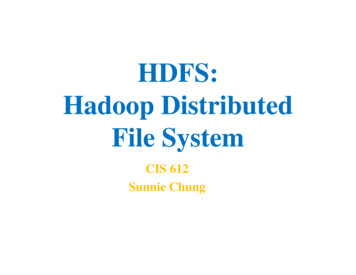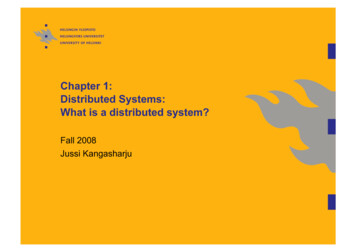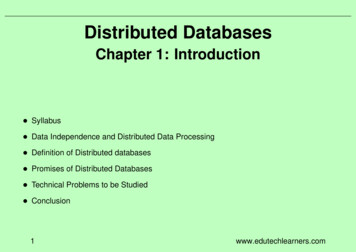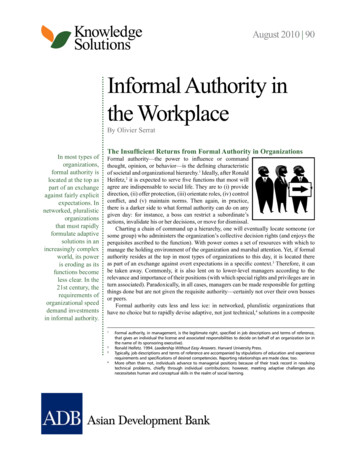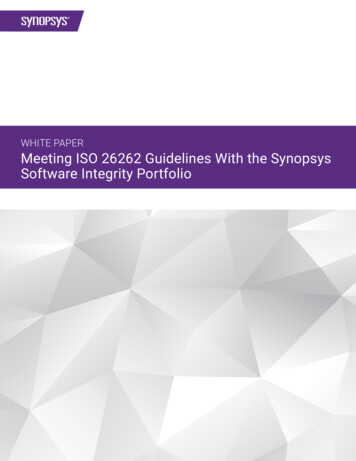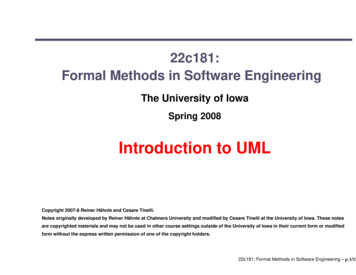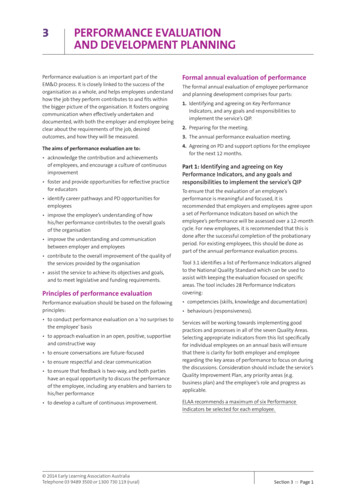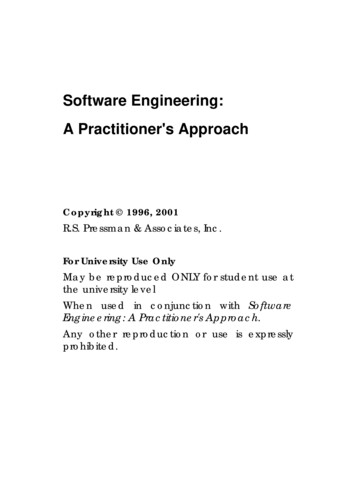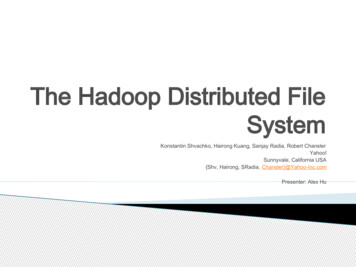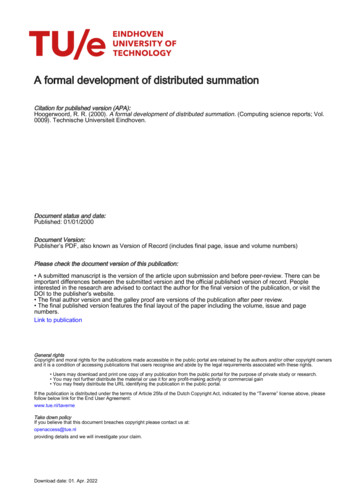
Transcription
A formal development of distributed summationCitation for published version (APA):Hoogerwoord, R. R. (2000). A formal development of distributed summation. (Computing science reports; Vol.0009). Technische Universiteit Eindhoven.Document status and date:Published: 01/01/2000Document Version:Publisher’s PDF, also known as Version of Record (includes final page, issue and volume numbers)Please check the document version of this publication: A submitted manuscript is the version of the article upon submission and before peer-review. There can beimportant differences between the submitted version and the official published version of record. Peopleinterested in the research are advised to contact the author for the final version of the publication, or visit theDOI to the publisher's website. The final author version and the galley proof are versions of the publication after peer review. The final published version features the final layout of the paper including the volume, issue and pagenumbers.Link to publicationGeneral rightsCopyright and moral rights for the publications made accessible in the public portal are retained by the authors and/or other copyright ownersand it is a condition of accessing publications that users recognise and abide by the legal requirements associated with these rights. Users may download and print one copy of any publication from the public portal for the purpose of private study or research. You may not further distribute the material or use it for any profit-making activity or commercial gain You may freely distribute the URL identifying the publication in the public portal.If the publication is distributed under the terms of Article 25fa of the Dutch Copyright Act, indicated by the “Taverne” license above, pleasefollow below link for the End User Agreement:www.tue.nl/taverneTake down policyIf you believe that this document breaches copyright please contact us at:openaccess@tue.nlproviding details and we will investigate your claim.Download date: 01. Apr. 2022
Technische Universiteit EindhovenDepartment of Mathematics and Computing ScienceA Formal Development of Distributed SummationRob R. Hoogerwoord00109ISSN 0926-4515All rights reservededitors:prof.dr. I.C.M. Baetenprof.dr. P.A.J. HilbersReports are available at:hltp:llwww.win.tue.nllwinlcsComputing Science Reports 00109Eindhoven, April 2000
A Formal Development of Distributed SummationRob R. Hoogerwoord11 april 2000
Contents0Introduction0.0 why formal reasoning? .0.1 the problem of distributed summation0.2 how we solve it.0.3 how to read this document0.4 notational conventions1 The Summation Phase1.0 specification .1.11.21.31.42calculation of the suma connecting graphprogressepilogueThe Connection Phase2.0 specification .2.1 connectivity .2.2 acyclicity.2.3 network compliance.2.4 progress3 Integration and Implementation3.0 a complete program3.1 shared variables and communication3.2 on33Bibliography364
Chapter 0Introd uctionChi va piano va sano.0.0why formal reasoning?Formal correctness proofs serve several purposes. First, a formal proof maybe needed for the purpose of a-posteriori (and possibly mechanical) verificiation of an already existing program. Second, a formal proof may provide aguideline for the construction of a program, thus giving rise to "correctness bydesign". Somewhere in between these two, a formal derivation of an already existing program may contribute to a better understanding of the mathematicalstructure of its design. This entails providing answers to questions like: whatmathematical properties are needed and where in the proof are they needed,and what design decisions have been taken and were these really necessary?Although this is an a-posteriori activity too, its emphasis is not on verification but on understanding. It is based on the observation that, however usefulformal verification is, the mere fact that somebody else, or even some machine,has verified a proof does not make me understand it any better. This understanding, in turn, is important if we wish to be able to design larger programsand still be able to guarantee their correctness.More specifically, by making design decisions explicit, alternative choicesbecome visible as well, and possibly variations of, if not improvements upon,the algorithm at hand may be identified. Thus, instead of a single algorithmactually a whole class of similar algorithms can be studied. For example, inall treatments of "Distributed Summation" I have seen [1, 2, 6], the use of arooted spanning tree is taken for granted; our development shows that thereis no logical necessity for such trees: a connected, acyclic, directed subgraphis what is needed, and a spanning tree is (just) one of the options.Another important aspect is the possibility to clearly separate problem-1
rh2542specific from general-mathematical knowledge needed in the proof: those stepsin the proof where problem-specific knowledge is used are the steps that distinguish the problem at hand from other problems; often these are also thesteps where design decisions are taken.In particular, the relation between a programming notation - a formalism - and its implementation - in terms of "execution traces" - is not specificfor any particular programming problem, but can be fixed once and for all forthat programming notation. Once the interface between notation and implementation has been established by means of proof rules, (correctness of) anyparticular program can be discussed in terms of these proof rules only.In this setting, "formal" means "constructed according to accurately formulated rules" ; these rules are not necessarily the rules of traditional formallogic. We call a proof "formal" if each step in it can be justified by an appealto one of the "accurately formulated rules". For our (practical) purposes,these rules are the rules of predicate calculus and of whatever well-understoodarea of mathematics we need. (For example: sets, bags, relations, functions,partial orders, mathematical induction, the natural numbers and the integersare considered well-understood.)0.1the problem of distributed summationIn this study we present a formal development of an algorithm for the problemknown as "Distributed Summation". Informally, the problem is to design adistributed algorithm for calculating the sum of a collection of numbers; thesenumbers are distributed over the nodes of a given finite network, in such away that every node holds one number. The computation is to be initiated byone dedicated node, called the TOot, and upon completion of the computationthe sum of all numbers is to be available in the root. The algorithm mustbe "truly distributed". This means that in every node in the network, noother information about the network is available than the identities of andthe communication links with that node's direct neighbours. As a result, thecomponent of the algorithm to be executed by a given node can only be basedon that (very local) information.The problem of "Distributed Summation" is of interest, because, first, it isabout the simplest example of a distributed computation and yet complicatedenough, and, second, it occurs as a subproblem in solutions to many otherproblems, such as distributed mutual exclusion, broadcast protocols, routingprotocols, and the like. Note that "summation" and "number" must not betaken too literally here: the solution is applicable to any algebraic structure
rh2543with a symmetric and associative binary operator; for example: booleans withdisjunction, conjunction, or equivalence, and sets or bags with union.0.2how we solve itTo a very large extent, distribution can be considered an implementation aspect: a distributed algorithm is just a parallel algorithm that happens to beimplemented in a distributed way. If communication in the parallel programis represented by shared variableso, and if every shared variable is shared byonly two parallel components (of the program), then every shared variable canbe implemented by means of a communication link between the two machinesexecuting those two components.If the number of available communication links in the underlying networkis limited, the number of pair-wise shared variables has to be equally limited. Hence, the design of the algorithm will certainly be influenced by therequirements of a distributed implementation, but otherwise we can reasonabout distributed algorithms in very much the same way we reason about"ordinary" parallel programs.In this study we use the Owicki-Gries formalism [5J to develop the solutionand its proof of correctness. Its main advantages are the simplicity of its rulesand the possibility to treat a program as a formal text in its own right; thisenables us to reason about a program without reasoning about its executiontraces.For an extensive treatment of the Owicki-Gries formalism and its applications to program construction, we refer to [OJ j here we confine ourselves to ashort summary of the main notions and technical issues, as used in this study: A (parallel) program is the parallel composition of a number of components, where a component is a sequential program fragment, constructedfrom (so-called) atomic statements. Variables occurring in at least two components are called shared variables, and variables occurring in only one component are called private.Here "occurring in" pertains to aEsignments and expressions aE well aEassertions and invariants. Properties of the program are formulated as pre- and post conditions ofthe program or of its components, and as system invariants. not to be confused with shared memory!
4rh254 During the development of a program, additional invariants, assertionsand statements in the program's components may (have to) be introduced. The precondition of the program must imply all preconditions of thecomponents, and the postconditions of the components in conjunctionmust imply the postcondition of the program. Every assertion in every component must be locally correct, which meansthat it must be a valid post assertion of the immediately preceding atomicstatement. Every assertion in every component must be globally correct, whichmeans that it is not violated by any atomic statement in any othercomponent. In such a proof the preassertion of that atomic statementmay be exploited; assertion Q is not violated by statement (with precondition) {P} S means: {QIIP} S {Q}. A (system) invariant is a predicate that is implied by the preconditionof the program and that is not violated by any of the atomic statementsin any of the components; as a result we may exploit an invariant as avalid assertion at any place in the program. A proposition { Q II P } S { Q} is trivially true if the variables occurringin Q are not modified in S. Whenever we prove global correctness of anassertion Q, we exploit this tacitly, by confining our attention to thosestatements in other components that do modify variables in Q. As aspecial case, if Q contains no shared variables at all, the requirement ofglobal correctness of Q is void. A proposition { Q II P} S { Q} is trivially true whenever Q and Paredisjoint, that is, [Q II P } false J. This is called the rule of disjointnessand it is an important technical device to achieve global correctness:particularly if S, all by itself, would violate Q, the only option is tostrengthen Q or P (or both) so as to obtain disjointness. (In operationalterms, this is also known as mutual exclusion.) Some statements do not violate an assertion but, on the contrary, makethe assertion only "more true"; this is called widening. Simple examplesare: assertion b and statement b: true, assertion b and statementb: false, and assertion x::; y and statement y: y 1. Widening statements can often be identified easily and, subsequently, be ignored.
rh2545 Synchronisation is needed to establish local correctness of an assertion,if this cannot be achieved otherwise. By way of experiment, we usethe notation {. B .} - "guard B" - as an abbreviation of what couldalso be written as await B, or as if B -- skip fi { B }: thus, we avoidthe operational connotations of the former and the elaborateness of thelatter. The construct {. B.} is both a statement and an assertion:as a statement, its execution requires B to be true and lllodifies novariables, and as an assertion, its local correctness is guaranteed. As aresult, {. B .} does not violate any other assertions, and the only proofobligation is the global correctness of the assertion B. The above only pertains to partial correctness, that is, without regardto progress properties, which must be proved separately. Fortunately,in many simple cases progress properties can be formulated as ordinarypredicates on the state of the system and can thus be treated as safetyproperties. As we will see, distributed summation is such a simple case. Step-by-step proof construction is possible, thanks to a monotonicityproperty: the introduction of additional assertions or invariants does notviolate the correctness of the already present assertions and invariants.In the same vein: strengthening a guard does not violate what alreadyis correct.0.3how to read this documentWe will develop the algorithm for distributed summation in a step-by-stepfashion, dealing with one aspect of the problem at a time. As a result, apresentation emerges that displays a good separation of concerns (but thatalso is rather long).To provide the reader with some assistance, we conclude every step witha summary of what has been achieved thus far. This summary is all thatis needed to understand the steps to follow: it is the interface between twosuccessive steps. Thus, the reader may (and even is advised to) skip someparts at first reading.The development proceeds in a top-down fashion: the introduction of newnotions and relations is postponed until they are really needed. This mayrequire some patience on the part of the reader, but it is an essential technique to maintain clarity and to prevent premature, if not unnecessary, designdecisions.
rh2546example: It is only by not taking the use of a spanning tree for grantedand by jorcing myself not to introduce it before the need would arise,that I was able to discover that we do not really need spanning treesat all.o0.4notational conventionsThroughout the development, variables i, j, n, p, q, R have type node, whereR is a constant, denoting the root node in the network. (Recall that the rootis the node initiating the computation.)We will introduce relations (on the set of nodes) named - and . Informally, if i - j then we (sometimes) call i a successor of j and call j apredecessor of i. Relation will be symmetric, and we (sometimes) call iand j each other's neighbours if i j .For these relations we denote their transitive closure by .2:- and ,t, respectively. Transitive closure can be defined in two, equivalent, ways. First,.2:- is the strongest of all transitive relations (say), satisfying:(lfi,j:: i -j ? i j)as a consequence of which we have both:(lfi,j:: i -j ? i.2:-j)and, for any transitive relation :(lfi, j : : i - j ?i j) ? (lfi, j : : i.2:- j ? i j)Second, can also be defined recursively by, for all i, j :. J, --i -j V (3p::i.2:-pl\p -j)We will use both definitions just as we see fit; the proof of their equivalencebelongs to the general-mathematical knowledge whose discussion falls outsidethe scope of this study.For any predicate Q , not universally false and possibly containing variable p,we sometimes use an abstract statement p: Q with the informal operationalmeaning "assign to p such a value that Q holds"; formally, this means that Qis a (locally) correct postassertion of this construct. We use it whenever wedo not wish to specify p more than that it should satisfy Q. For example:p: p -q means "select an (arbitrary) successor of q and assign it to p".
Chapter 1The Summation Phase1.0specificationEvery node j has an integer variable Xj, whose initial value is the numberheld by that node; we do not require that Xj retains its initial value: it is atrue variable. In addition, the root node R has an integer variable y that,upon completion of the computation, is equal to the sum of the initial valuesof the variables x. For the sake of simplicity, we assume y 0 initially.To formalize this, we introduce a constant C as (a name for) the sum ofthe initial values of the variables x. So, the precondition of the algorithm is:C (I;j::Xj)1\Y 0and its postcondition can now be formulated as:C yA distributed algorithm for this problem will be the parallel composition of anumber of components, one per node of the network. The informal requirementthat "upon completion of the computation the sum of all numbers is to beavailable in the root" is properly reflected in the above postcondition, becausey is a variable of the root. Nevertheless, this is not sufficient because howcould, in a truly distributed system, the root possibly detect that the wholecomputation has terminated? So, we must strengthen the specification: werequire C y to be a (local) postcondition of the root component. Thus weachieve that C y holds as soon as the root has terminated.The algorithm should be such that, in its final implementation, all communication is restricted to neighbouring nodes in the (given) network, but thisrequirement, which we call network compliance here, will enter the design ina rather late stage.7
8rh2541.1calculation of the sumIn our first approximation to the solution the correct answer will be calculated,without much regard to the requirements of a distributed implementation.Were we heading for a traditional sequential program, a simple iterationof y: y x q , for all q, would do the job - given that y is zero initially-.A distributed implementation of this iteration is hard to envisage, however,because of the central role played by variable y.Therefore, we investigate assignments of the shape xp: xp Xq (for judiciously chosen p and q). Because somehow y has to obtain a value, we alsowill need assignments - at least one - of the shape y: . .In addition we introduce a boolean variable bj , one for every node j, todistinguish the variables that still contribute to the answer from the variablesthat do not anymore. Thus, we propose the following system invariant:CQO: y ( j: bj: Xj)As usual, QO captures what the pre- and postconditions of the problem havein common. QO is implied by the precondition, provided initially variables band y satisfy:y 0/\(V j : : bj)The required postcondition, C y , follows from QO if, in addition:So, the main purpose of the algorithm now is to set all booleans b tofalse 1 under invariance of QO. To this end, each assignment to a b n1ust beaccompagnied by an assignment to one of the integer variables. We investigatethis separately for the root node and for all other nodes.The root R has C y as its postcondition, which follows from QO provided (Vj : : bj ) is a valid postcondition of R as well. This, in turn, givesrise to (V j : R7' j : bj ) as a necessary precondition of bR: false, which wetherefore add as a guard. With this precondition and with bR, we now havethat ( j: bj : Xj) is equal to XR, so the only thing we can do here is combinebR: false with y: Y XR. Thus, we obtain as component program for R:aMR:{bR Ho (Vj: R7'j: bj) o}y,b R : y xR,false{ (Vj : : bj ) , hence: C y }
rh2549For any p and q satisfying polq /\ bp/\bq we have:which, in turn, can be rewritten as:This observation yields the following component for node q, for every q suchthat RoIq; the global correctness of the assertion labelled with ? remainsto be established yet:add·q:{ bq }p: polq /\ bp{ polq /\ bp ? }xp, bqxp Xq, false{ ,bq }aside: In all its simplicity, the above proposal represents quite a few design decisions; for instance, we could try to do without the booleansb and we could propose operations like xp, Xq : xp x q , 0 , or evenxp, Xq : xp h, Xq - h , for any h. We shall not pursue this, but atthe moment I have no evidence that such an approach would fail.Our booleans b have been introduced to record more explicitlywhich of the variables x are still relevant; as is already visible in add·R,they also playa role in the synchronization of the components.oWe conclude this (and each next) subsection with a summary of the currentapproximation, so as to provide a clear interface between the successive stepsin the development: this summary is all that matters for what is to follow,and all preceding considerations may now be forgotten.The first approximation to the algorithm is the parallel composition of thecomponents add·q, for all q (including R).summary 0 : (reminder: assertions between { . } are guards.)pre:CQO:C y (Ej:bj:xj)post:(Vj::,b j ) (Ej::xj)/\ Y 0 /\ (Vj::b j )
rh25410add·R:{ bR H. (Vj : R#j: .bj ) .}y, bR : Y XR, false{ (V j : : bj ) , hence: C Y }and for each g different from R:add·g:{ bq}p: p#g II bp{ p#g II bp ? }x p , bq . xp Xq,{ .bqfalse}D1.2a connecting graphIn view of the desire for a distributed implementation, the guard of add·R isawkward: it refers to all other boolean variables of the program, and thus itis much too global an expression. Rather, we prefer to formulate all guards inlocal terms only, where "local" means "involving a modest amount of sharedvariables only" .So, we need a way to draw global conclusions from local assertions. Forthis purpose, we introduce a binary relation - on the set of nodes; for thetime being, f - is constant. We write for the transitive closure of t--.In what follows, we will derive by careful analysis what properties - shouldhave such that it serves our purposes well.We begin with introducing an additional invariant, coupling relation to the boolean variables b:Ql:(Vi,j: i -j: bi bj)The expression bi bj also defines a relation on the nodes, and this relation is transitive. Hence, from the definition of transitive closure, we obtainas a corollary of Ql the following stronger property for free:Ql : (Vi,j: i !:- j : bi bj)remark: This is why the transitive closure is useful: Ql is formulatedin "local" terms, namely pairs of nodes related by -, and Ql is astronger - "more global" - property, in terms of pairs related by !:-.D
rh25411Now we derive:QI }{instantiation i : R }(lIj: R.:t-j : bR bj){ predicate calculus} }bR V (lIj: R.:t-j: ,bj ){ assuming RO , see below }bR V (lIj: Rh: ,bj){ predicate calculus }bR V (lIj::,b j)from which we conclude that, provided QI is invariant indeed, we have,b R } (II j : : ,bj ) . As a result, the guard of add· R can be removed, becauseits raison d'etre has disappeared: the additional postcondition (lIj:: ,bj ) ofadd·R is now implied by QI /\ ,bR .In the above derivation we have assumed that relation - satisfies thefollowing requirement of (what we call) connectivity:RO:(lIj : Relj : R.:t- j)For the time being we just put RO on our list of requirements imposed upon c- ;these requirelnents will be dealt with in the connection phase.***A new invariant generates new proof obligations. In our case, QI is impliedby the precondition of the whole program, and, both for R q and for Relq,the additional precondition, as required by QI, for add·q is:We add this precondition as a guard to add'q, and because it is stable, it alsois a globally correct assertion. It is sufficiently "local" , provided not too manyj satisfy q - j .***
rh25412Invariant Q1 can also be used to establish the global correctness of the assertion p";q /\ bp , in add·q: we now require p to satisfy p --q, such that bpfollows from Q1 and bq . If, in addition, -- is i1Teflexive then p -- q impliesp";q as well.remark: We do not put irreflexivity on our list of requirements imposedupon --, because it will follow from a stronger requirement that wewill need later anyhow.oThat a p satisfying p f - q exists follows from the following little lemma.lemma:R";q'*(3p:: p --q)proof: From RO /\ R"; q, we conclude R? q, and we derive:R?q{ transitive closure }R --q V (3p:: R?p /\ p --q)'*{ weakening }R --q V (3p:: p -- q){ absorption }(3p:: p --q)oAs we have no particular reason to prefer one successor of q over theother, we deliberately formulate the choice of p nondeterministic ally here,thus effectively leaving it to the implementation.Thus, we have arrived at our second, and final approximation of the summation phase, in which all assertions are correct now, albeit that we still mustprove progress.summary 1 :pre:c QO:C y ( j:bj:Xj)Ql:(Vi,j: i --j : bipost:(Vj::( j::Xj) bj)/\ y O /\ (Vj::b j- bj))
rh254add·R:13{bR} {o (Vj: R -j: ,bj) o}y, bR : Y XR, false{ ,bR , hence: C Y }and for each q different from R:add·q:{ bq } { 0 (V j : q - j : ,bj ) o}p: p -q{ bq } { p -q, hence: Pi'q /\ bpxP' bq . - xp Xq, false{ ,bq }} {(Vj: q -j: ,bj) }o1.3progressIn this simple case, progress can be formulated as a safety property. Informally,the shape of the proof obligation for progress is:"the final state has not been reached" *"the guard of at least one operation is true"Because, for every q, component add·q has (Vj: q - j: ,bj ) as its guard,the proof obligation to demonstrate progress for our second approximation is:(3i ::bi ) *(3i:: bi1\(Vj :i -j: ,bj))By means of contraposition and predicate calculus, this can be rewritten as:(Vi::,b i ) (Vi:: ,bi (Vj:i -j:,b j ))Now, this is just the proposition that the relation - admits proofs byMathematical Induction - read i - j as "j less than i" , if you like -, which isequivalent to the proposition that the relation - is Well-Founded.Because the domain of - - the set of nodes - is finite, Well-Foundednessof f - is equivalent to the requirement that the relation - is acyclic, whichmeans that .2:. is irreflexive.So, progress of our last approximation is guaranteed, provided --- satisfiesthe additional requirement of acyclicity:R1:(Vj:: ,(j.2:.j))Because, by the definition of transitive closure, - impliesthat acyclicity of - implies irreflexivity of - , as required.2:., we have
141.4rh254epilogueThe correctness of the program for the summation phase depends on the following properties of the relation -.RO:(Vj: Rioj: R !:-j)connectivityR1:(Vj::,(j !:-j))acyclicityWe may view the set of nodes together with - as a directed graph. In thejargon of graphs property RO states that the root node R is reachable fromevery other node in the graph, whereas R1 states that this graph is acyclic.***The implementation of the shared variables in the algorithm requires communications over the network on which the algorithm will be implemented. Inthe current algorithm, every two components sharing variables are related by;-. For the sake of implement ability we now require - to be such thatrelated pairs of nodes are connected by a communication link in the network.This is formally rendered by requirement R2, in which "being connected bya communication link" is denoted byR2:(Vi,j: i -j:i j)complianceThe smallest possible graph having these properties is a rooted, directed,spanning tree over the network. In all other presentations of this algorithm Ihave seen [1, 2, 6] , this tree is introduced right from the start, and its necessityis taken for granted. Our development shows that, at least up to this point inthe development, there is no need to restrict this graph to such a tree.Of course, because in add·q exactly one successor p of q is chosen towhich Xq is communicated, the actual communication pattern along whichthe numbers are collected is a tree indeed. The above development shows,however, that the choice of p in add·q can be postponed to the very lastmoment: there is no need to fix the tree in an earlier stage of the computation.In addition, we now obtain a variation of the current solution for free: Xqmay be split into several numbers, their sum equal to x q , and these individualnumbers may be added one by one to x p ; in each such addition a differentsuccessor p may be chosen! This may even be of some practical value, forinstance, when the values involved are not numbers but large sets of data: suchsplitting up may then contribute to a better load balancing in the underlyingnetwork.
rh254remarks: Whether or not such a variation is of practical value is irrelevanthere: in many practical implementations the a priori restriction to atree may be perfectly defensible. What is important, though, is thatdesign decisions are made explicit as much as possible, and the aboveshows that the restriction to a tree is a true design decision.When I was making preparations to write this report, I still believedthat in the second part - the connection phase - I would inevitably runinto the need to restrict as yet the connecting graph to a tree. To myown surprise, this did not happen!o15
Chapter 2The Connection Phase2.0specificationThe algorithm for the summation phase requires the existence of a binaryrelation - on the nodes, satisfying the following three requirements:RO:(lIj: Rh : R j)connectivityR1:(II j :: ,(j j) )acyclicityR2:(lIi,j: i - j : i j)complianceThe purpose of the connection phase is to compute such a relation; in thisphase - is a variable, of type boolean function on pairs of nodes, and tobe given such a value that the three requirements are met. We assume thatinitially no pairs of nodes are related by - at all. So, the specification of theconnection phase is:pre:(lIi,j:: ,(i -j))post:RO 1\ R1 1\ R2To start with, we will develop a solution in isolation, without regard tohow the connection phase will interact with the summation phase; this willbe dealt with later, in Section 3.0. (Recall that in the development of thealgorithm for the summation phase, we have treated - as a constant, whichis not true anymore.)As before, we will develop the solution in a step-by-step fashion, takingthe three reqnirements into account one by
rh254 3 with a symmetric and associative binary operator; for example: booleans with disjunction, conjunction, or equivalence, and sets or bags with union. 0.2 how we solve it To a very large extent, distribution can be considered an implementation as pect: a distributed

